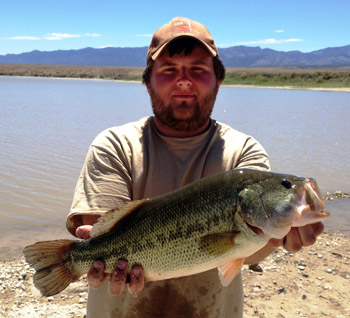
GUNLOCK — Water levels in southwestern Utah are the lowest they’ve been in years. Many of the reservoirs are at critically low levels. And some of the streams are barely flowing.

Richard Hepworth, regional fisheries manager for the Division of Wildlife Resources, said sometimes biologists have to get creative to manage fish during a drought.
“Even with low water levels,” he said, “in some areas, we can usually preserve fish populations using some aggressive management techniques.”
Gunlock Reservoir is a prime example. The water level at Gunlock is the lowest it’s been in years. Combined with some siltation that occurred in the past, the reservoir doesn’t have enough water to support the fish that live there.
“Gunlock has been a great warm water fishery for many years,” Hepworth said. “Bass, crappie and bluegill do really well there. But the water level has gotten so low that we have to do something different to save some fish.”
That something different involved recruiting a group of volunteers to fish at Gunlock.
On the morning of June 30, several anglers from various bass fishing clubs, and members of Utah’s Dedicated Hunter program, showed up — with rods and reels and bass boats — to help biologists catch as many fish as possible.
Utah State Parks and the Washington County Water Conservancy District also provided help and support. Once the fish were caught, biologists moved them to various waters.
“All of the smallmouth bass were sent to Newcastle Reservoir,” said Mike Hadley, DWR regional fisheries biologist . “The crappie, and many of the largemouth bass and bluegill, were released in Garrison Reservoir. The remainder of the largemouth bass and bluegill were released in community fishing ponds in central Utah.”
Regarding smallmouth bass, Hepworth said the DWR has an agreement with the federal government to not put smallmouth into any ponds or lakes that drain into the Virgin River.
“Smallmouth do really well in river systems,” Hepworth said. “If they get into the Virgin River, they’ll prey on native fish and out compete them for food and space.”
Gunlock is one of the water bodies that’s connected with the river.
“All of the smallmouth have to come out of Gunlock,” Hepworth said. “In addition to the help we received on June 30, we’re using an electrofishing boat to catch even more smallmouth.”
Hepworth said electro-fishing boats send an electric current through the water. The current momentarily stuns fish, and the fish float to the surface. Biologists then net the fish and place them in live wells.
“After a few seconds, the fish revive,” Hepworth said. “They don’t suffer any ill effects from the experience.”
Hepworth said smallmouth bass were placed in Gunlock illegally. Since being placed there, they’ve increased in number.
“If we can’t eradicate the smallmouth by moving them to other waters,” he said, “we may have to remove all of the fish in the reservoir by treating it at a later date.”
For more information, call the DWR’s Southern Region office at 435-865-6100
Related posts
- Teen girl falls from ledge onto rocks at Gunlock Reservoir
- Lake to Lake Relay, Gunlock to Sand Hollow; late registration options
- Take part in Free Fishing Day, survey to improve Utah fishing
mail: [email protected]
Twitter: @STGnews
Water levels are low.. currently Gunlock is at 40% capacity. However let’s be clear, there is plenty of water to sustain the current fish population in Gunlock. However, ALL of the smallmouth need to be removed, and that has nothing to do with water levels. That is the main reason for this project. It just so happens that this year the lake is substantially lower than it has been the past 3-4 years.
This is a very informative and well written article.
Before it was a reservoir it was a river. Mankind comes along, creates a government and then sets out to save something that doesn’t need saving. Seems such a waste of time and money. If the reservoir went dry for a season or two, it would re-fill and fish could be re-introduced. Let Nature run its course, the fish are not unique. The real reason here is not the fish, it’s the preservation of employment.